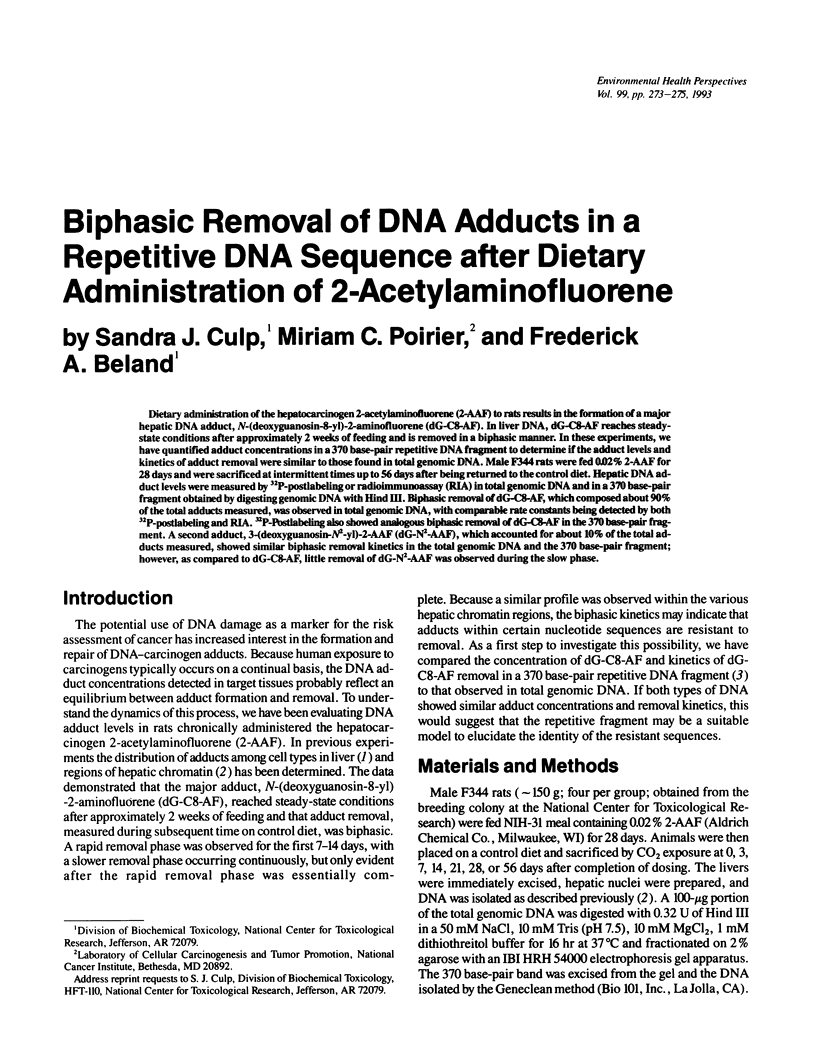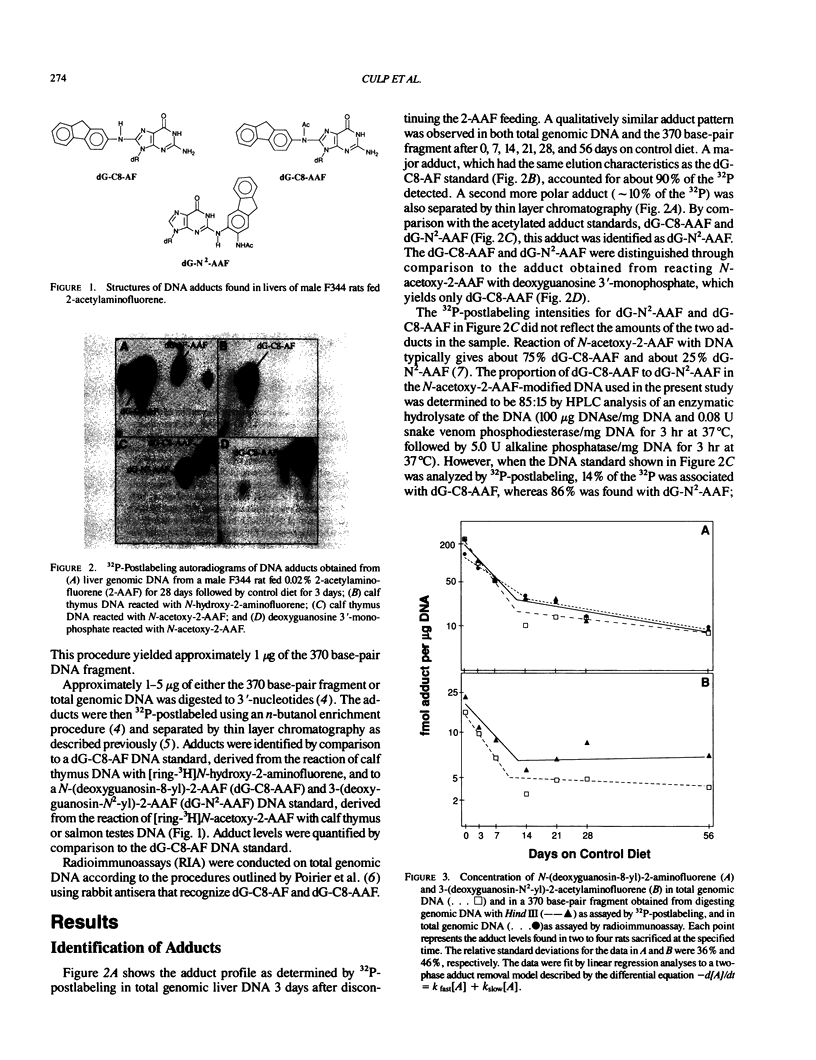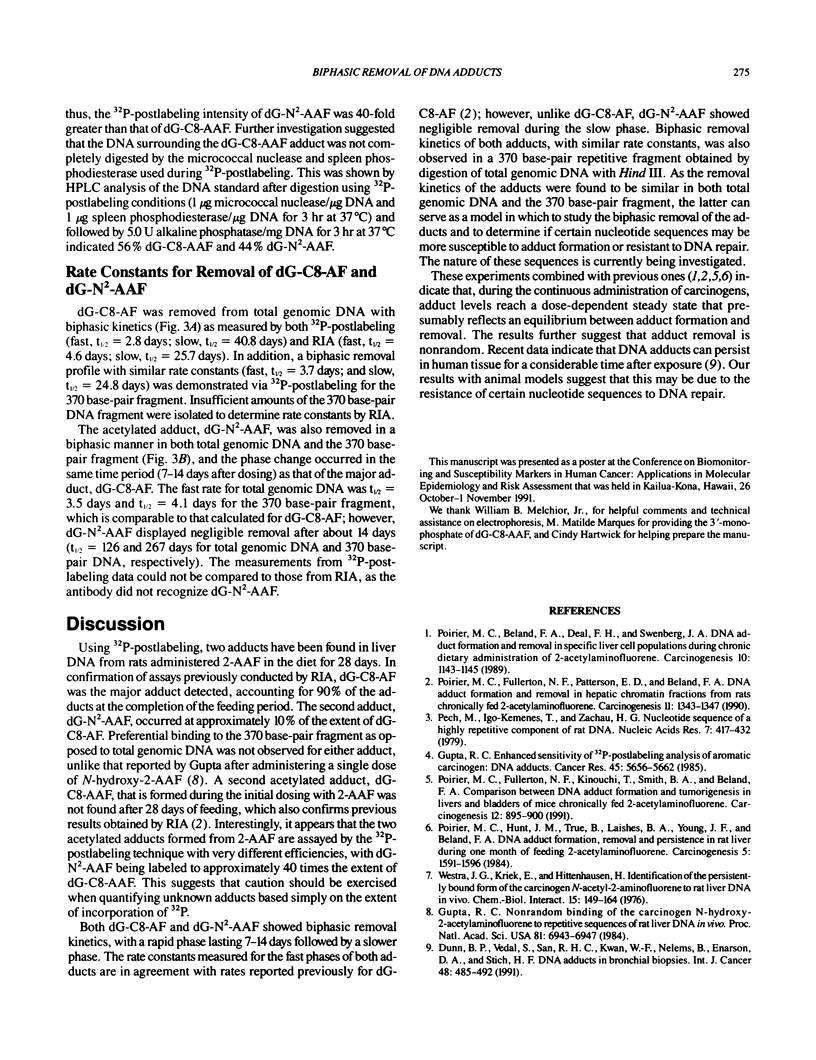Abstract
Dietary administration of the hepatocarcinogen 2-acetylaminofluorene (2-AAF) to rats results in the formation of a major hepatic DNA adduct, N-(deoxyguanosin-8-yl)-2-aminofluorene (dG-C8-AF). In liver DNA, dG-C8-AF reaches steady-state conditions after approximately 2 weeks of feeding and is removed in a biphasic manner. In these experiments, we have quantified adduct concentrations in a 370 base-pair repetitive DNA fragment to determine if the adduct levels and kinetics of adduct removal were similar to those found in total genomic DNA. Male F344 rats were fed 0.02% 2-AAF for 28 days and were sacrificed at intermittent times up to 56 days after being returned to the control diet. Hepatic DNA adduct levels were measured by 32P-postlabeling or radioimmunoassay (RIA) in total genomic DNA and in a 370 base-pair fragment obtained by digesting genomic DNA with Hind III. Biphasic removal of dG-C8-AF, which composed about 90% of the total adducts measured, was observed in total genomic DNA, with comparable rate constants being detected by both 32P-postlabeling and RIA. 32P-Postlabeling also showed analogous biphasic removal of dG-C8-AF in the 370 base-pair fragment. A second adduct, 3-(deoxyguanosin-N2-yl)-2-AAF (dG-N2-AAF), which accounted for about 10% of the total adducts measured, showed similar biphasic removal kinetics in the total genomic DNA and the 370 base-pair fragment; however, as compared to dG-C8-AF, little removal of dG-N2-AAF was observed during the slow phase.
Full text
PDF


Images in this article
Selected References
These references are in PubMed. This may not be the complete list of references from this article.
- Dunn B. P., Vedal S., San R. H., Kwan W. F., Nelems B., Enarson D. A., Stich H. F. DNA adducts in bronchial biopsies. Int J Cancer. 1991 Jun 19;48(4):485–492. doi: 10.1002/ijc.2910480403. [DOI] [PubMed] [Google Scholar]
- Gupta R. C. Enhanced sensitivity of 32P-postlabeling analysis of aromatic carcinogen:DNA adducts. Cancer Res. 1985 Nov;45(11 Pt 2):5656–5662. [PubMed] [Google Scholar]
- Gupta R. C. Nonrandom binding of the carcinogen N-hydroxy-2-acetylaminofluorene to repetitive sequences of rat liver DNA in vivo. Proc Natl Acad Sci U S A. 1984 Nov;81(22):6943–6947. doi: 10.1073/pnas.81.22.6943. [DOI] [PMC free article] [PubMed] [Google Scholar]
- Pech M., Igo-Kemenes T., Zachau H. G. Nucleotide sequence of a highly repetitive component of rat DNA. Nucleic Acids Res. 1979 Sep 25;7(2):417–432. doi: 10.1093/nar/7.2.417. [DOI] [PMC free article] [PubMed] [Google Scholar]
- Poirier M. C., Beland F. A., Deal F. H., Swenberg J. A. DNA adduct formation and removal in specific liver cell populations during chronic dietary administration of 2-acetylaminofluorene. Carcinogenesis. 1989 Jun;10(6):1143–1145. doi: 10.1093/carcin/10.6.1143. [DOI] [PubMed] [Google Scholar]
- Poirier M. C., Fullerton N. F., Kinouchi T., Smith B. A., Beland F. A. Comparison between DNA adduct formation and tumorigenesis in livers and bladders of mice chronically fed 2-acetylaminofluorene. Carcinogenesis. 1991 May;12(5):895–900. doi: 10.1093/carcin/12.5.895. [DOI] [PubMed] [Google Scholar]
- Poirier M. C., Fullerton N. F., Patterson E. D., Beland F. A. DNA adduct formation and removal in hepatic chromatin fractions from rats chronically fed 2-acetylaminofluorene. Carcinogenesis. 1990 Aug;11(8):1343–1347. doi: 10.1093/carcin/11.8.1343. [DOI] [PubMed] [Google Scholar]
- Poirier M. C., Hunt J. M., True B. A., Laishes B. A., Young J. F., Beland F. A. DNA adduct formation, removal and persistence in rat liver during one month of feeding 2-acetylaminofluorene. Carcinogenesis. 1984 Dec;5(12):1591–1596. doi: 10.1093/carcin/5.12.1591. [DOI] [PubMed] [Google Scholar]
- Westra J. G., Kriek E., Hittenhausen H. Identification of the persistently bound form of the carcinogen N-acetyl-2-aminofluorene to rat liver DNA in vivo. Chem Biol Interact. 1976 Oct 2;15(2):149–164. doi: 10.1016/0009-2797(76)90160-5. [DOI] [PubMed] [Google Scholar]



